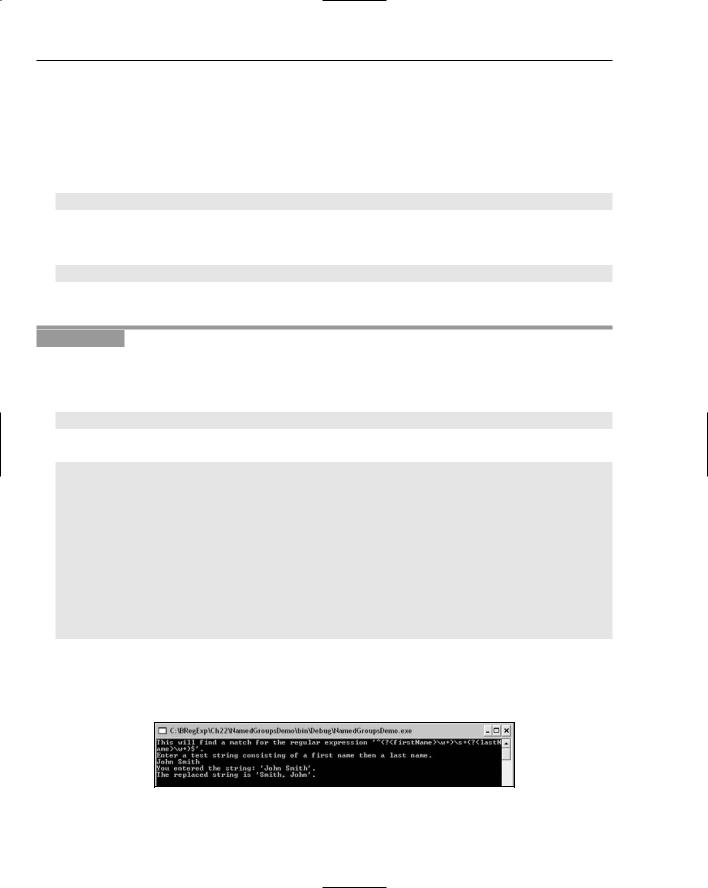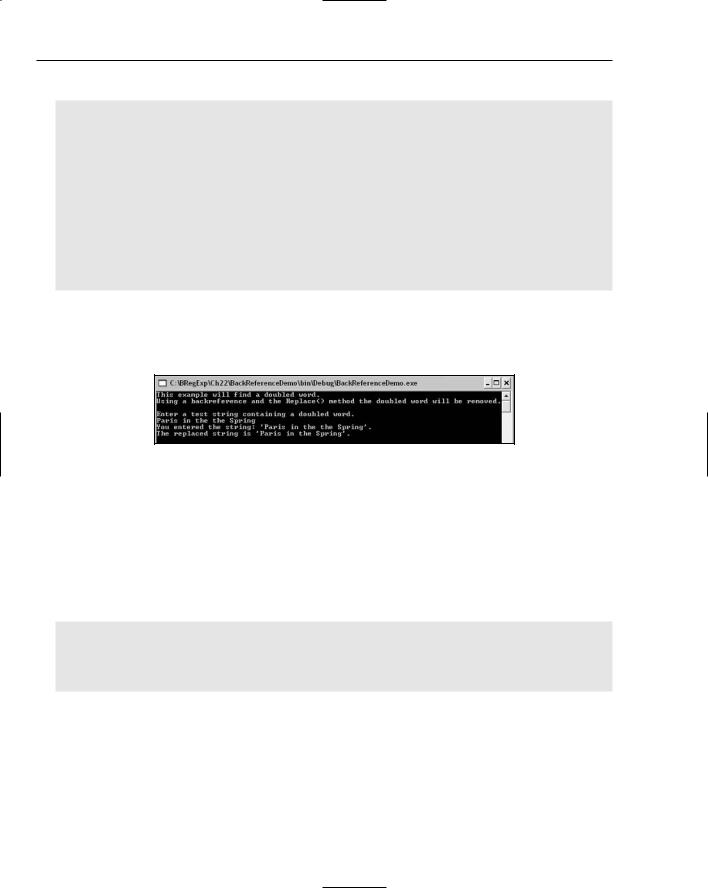
- •Introduction
- •Who This Book Is For
- •What This Book Covers
- •How This Book Is Structured
- •What You Need to Use This Book
- •Conventions
- •Source Code
- •Errata
- •p2p.wrox.com
- •What Are Regular Expressions?
- •What Can Regular Expressions Be Used For?
- •Finding Doubled Words
- •Checking Input from Web Forms
- •Changing Date Formats
- •Finding Incorrect Case
- •Adding Links to URLs
- •Regular Expressions You Already Use
- •Search and Replace in Word Processors
- •Directory Listings
- •Online Searching
- •Why Regular Expressions Seem Intimidating
- •Compact, Cryptic Syntax
- •Whitespace Can Significantly Alter the Meaning
- •No Standards Body
- •Differences between Implementations
- •Characters Change Meaning in Different Contexts
- •Regular Expressions Can Be Case Sensitive
- •Case-Sensitive and Case-Insensitive Matching
- •Case and Metacharacters
- •Continual Evolution in Techniques Supported
- •Multiple Solutions for a Single Problem
- •What You Want to Do with a Regular Expression
- •Replacing Text in Quantity
- •Regular Expression Tools
- •findstr
- •Microsoft Word
- •StarOffice Writer/OpenOffice.org Writer
- •Komodo Rx Package
- •PowerGrep
- •Microsoft Excel
- •JavaScript and JScript
- •VBScript
- •Visual Basic.NET
- •Java
- •Perl
- •MySQL
- •SQL Server 2000
- •W3C XML Schema
- •An Analytical Approach to Using Regular Expressions
- •Express and Document What You Want to Do in English
- •Consider the Regular Expression Options Available
- •Consider Sensitivity and Specificity
- •Create Appropriate Regular Expressions
- •Document All but Simple Regular Expressions
- •Document What You Expect the Regular Expression to Do
- •Document What You Want to Match
- •Test the Results of a Regular Expression
- •Matching Single Characters
- •Matching Sequences of Characters That Each Occur Once
- •Introducing Metacharacters
- •Matching Sequences of Different Characters
- •Matching Optional Characters
- •Matching Multiple Optional Characters
- •Other Cardinality Operators
- •The * Quantifier
- •The + Quantifier
- •The Curly-Brace Syntax
- •The {n} Syntax
- •The {n,m} Syntax
- •Exercises
- •Regular Expression Metacharacters
- •Thinking about Characters and Positions
- •The Period (.) Metacharacter
- •Matching Variably Structured Part Numbers
- •Matching a Literal Period
- •The \w Metacharacter
- •The \W Metacharacter
- •Digits and Nondigits
- •The \d Metacharacter
- •Canadian Postal Code Example
- •The \D Metacharacter
- •Alternatives to \d and \D
- •The \s Metacharacter
- •Handling Optional Whitespace
- •The \S Metacharacter
- •The \t Metacharacter
- •The \n Metacharacter
- •Escaped Characters
- •Finding the Backslash
- •Modifiers
- •Global Search
- •Case-Insensitive Search
- •Exercises
- •Introduction to Character Classes
- •Choice between Two Characters
- •Using Quantifiers with Character Classes
- •Using the \b Metacharacter in Character Classes
- •Selecting Literal Square Brackets
- •Using Ranges in Character Classes
- •Alphabetic Ranges
- •Use [A-z] With Care
- •Digit Ranges in Character Classes
- •Hexadecimal Numbers
- •IP Addresses
- •Reverse Ranges in Character Classes
- •A Potential Range Trap
- •Finding HTML Heading Elements
- •Metacharacter Meaning within Character Classes
- •The ^ metacharacter
- •How to Use the - Metacharacter
- •Negated Character Classes
- •Combining Positive and Negative Character Classes
- •POSIX Character Classes
- •The [:alnum:] Character Class
- •Exercises
- •String, Line, and Word Boundaries
- •The ^ Metacharacter
- •The ^ Metacharacter and Multiline Mode
- •The $ Metacharacter
- •The $ Metacharacter in Multiline Mode
- •Using the ^ and $ Metacharacters Together
- •Matching Blank Lines
- •Working with Dollar Amounts
- •Revisiting the IP Address Example
- •What Is a Word?
- •Identifying Word Boundaries
- •The \< Syntax
- •The \>Syntax
- •The \b Syntax
- •The \B Metacharacter
- •Less-Common Word-Boundary Metacharacters
- •Exercises
- •Grouping Using Parentheses
- •Parentheses and Quantifiers
- •Matching Literal Parentheses
- •U.S. Telephone Number Example
- •Alternation
- •Choosing among Multiple Options
- •Unexpected Alternation Behavior
- •Capturing Parentheses
- •Numbering of Captured Groups
- •Numbering When Using Nested Parentheses
- •Named Groups
- •Non-Capturing Parentheses
- •Back References
- •Exercises
- •Why You Need Lookahead and Lookbehind
- •The (? metacharacters
- •Lookahead
- •Positive Lookahead
- •Negative Lookahead
- •Positive Lookahead Examples
- •Positive Lookahead in the Same Document
- •Inserting an Apostrophe
- •Lookbehind
- •Positive Lookbehind
- •Negative Lookbehind
- •How to Match Positions
- •Adding Commas to Large Numbers
- •Exercises
- •What Are Sensitivity and Specificity?
- •Extreme Sensitivity, Awful Specificity
- •Email Addresses Example
- •Replacing Hyphens Example
- •The Sensitivity/Specificity Trade-Off
- •Sensitivity, Specificity, and Positional Characters
- •Sensitivity, Specificity, and Modes
- •Sensitivity, Specificity, and Lookahead and Lookbehind
- •How Much Should the Regular Expressions Do?
- •Abbreviations
- •Characters from Other Languages
- •Names
- •Sensitivity and How to Achieve It
- •Specificity and How to Maximize It
- •Exercises
- •Documenting Regular Expressions
- •Document the Problem Definition
- •Add Comments to Your Code
- •Making Use of Extended Mode
- •Know Your Data
- •Abbreviations
- •Proper Names
- •Incorrect Spelling
- •Creating Test Cases
- •Debugging Regular Expressions
- •Treacherous Whitespace
- •Backslashes Causing Problems
- •Considering Other Causes
- •The User Interface
- •Metacharacters Available
- •Quantifiers
- •The @ Quantifier
- •The {n,m} Syntax
- •Modes
- •Character Classes
- •Back References
- •Lookahead and Lookbehind
- •Lazy Matching versus Greedy Matching
- •Examples
- •Character Class Examples, Including Ranges
- •Whole Word Searches
- •Search-and-Replace Examples
- •Changing Name Structure Using Back References
- •Manipulating Dates
- •The Star Training Company Example
- •Regular Expressions in Visual Basic for Applications
- •Exercises
- •The User Interface
- •Metacharacters Available
- •Quantifiers
- •Modes
- •Character Classes
- •Alternation
- •Back References
- •Lookahead and Lookbehind
- •Search Example
- •Search-and-Replace Example
- •Online Chats
- •POSIX Character Classes
- •Matching Numeric Digits
- •Exercises
- •Introducing findstr
- •Finding Literal Text
- •Quantifiers
- •Character Classes
- •Command-Line Switch Examples
- •The /v Switch
- •The /a Switch
- •Single File Examples
- •Simple Character Class Example
- •Find Protocols Example
- •Multiple File Example
- •A Filelist Example
- •Exercises
- •The PowerGREP Interface
- •A Simple Find Example
- •The Replace Tab
- •The File Finder Tab
- •Syntax Coloring
- •Other Tabs
- •Numeric Digits and Alphabetic Characters
- •Quantifiers
- •Back References
- •Alternation
- •Line Position Metacharacters
- •Word-Boundary Metacharacters
- •Lookahead and Lookbehind
- •Longer Examples
- •Finding HTML Horizontal Rule Elements
- •Matching Time Example
- •Exercises
- •The Excel Find Interface
- •Escaping Wildcard Characters
- •Using Wildcards in Data Forms
- •Using Wildcards in Filters
- •Exercises
- •Using LIKE with Regular Expressions
- •The % Metacharacter
- •The _ Metacharacter
- •Character Classes
- •Negated Character Classes
- •Using Full-Text Search
- •Using The CONTAINS Predicate
- •Document Filters on Image Columns
- •Exercises
- •Using the _ and % Metacharacters
- •Testing Matching of Literals: _ and % Metacharacters
- •Using Positional Metacharacters
- •Using Character Classes
- •Quantifiers
- •Social Security Number Example
- •Exercises
- •The Interface to Metacharacters in Microsoft Access
- •Creating a Hard-Wired Query
- •Creating a Parameter Query
- •Using the ? Metacharacter
- •Using the * Metacharacter
- •Using the # Metacharacter
- •Using the # Character with Date/Time Data
- •Using Character Classes in Access
- •Exercises
- •The RegExp Object
- •Attributes of the RegExp Object
- •The Other Properties of the RegExp Object
- •The test() Method of the RegExp Object
- •The exec() Method of the RegExp Object
- •The String Object
- •Metacharacters in JavaScript and JScript
- •SSN Validation Example
- •Exercises
- •The RegExp Object and How to Use It
- •Quantifiers
- •Positional Metacharacters
- •Character Classes
- •Word Boundaries
- •Lookahead
- •Grouping and Nongrouping Parentheses
- •Exercises
- •The System.Text.RegularExpressions namespace
- •A Simple Visual Basic .NET Example
- •The Classes of System.Text.RegularExpressions
- •The Regex Object
- •Using the Match Object and Matches Collection
- •Using the Match.Success Property and Match.NextMatch Method
- •The GroupCollection and Group Classes
- •The CaptureCollection and Capture Class
- •The RegexOptions Enumeration
- •Case-Insensitive Matching: The IgnoreCase Option
- •Multiline Matching: The Effect on the ^ and $ Metacharacters
- •Right to Left Matching: The RightToLeft Option
- •Lookahead and Lookbehind
- •Exercises
- •An Introductory Example
- •The Classes of System.Text.RegularExpressions
- •The Regex Class
- •The Options Property of the Regex Class
- •Regex Class Methods
- •The CompileToAssembly() Method
- •The GetGroupNames() Method
- •The GetGroupNumbers() Method
- •GroupNumberFromName() and GroupNameFromNumber() Methods
- •The IsMatch() Method
- •The Match() Method
- •The Matches() Method
- •The Replace() Method
- •The Split() Method
- •Using the Static Methods of the Regex Class
- •The IsMatch() Method as a Static
- •The Match() Method as a Static
- •The Matches() Method as a Static
- •The Replace() Method as a Static
- •The Split() Method as a Static
- •The Match and Matches Classes
- •The Match Class
- •The GroupCollection and Group Classes
- •The RegexOptions Class
- •The IgnorePatternWhitespace Option
- •Metacharacters Supported in Visual C# .NET
- •Using Named Groups
- •Using Back References
- •Exercise
- •The ereg() Set of Functions
- •The ereg() Function
- •The ereg() Function with Three Arguments
- •The eregi() Function
- •The ereg_replace() Function
- •The eregi_replace() Function
- •The split() Function
- •The spliti() Function
- •The sql_regcase() Function
- •Perl Compatible Regular Expressions
- •Pattern Delimiters in PCRE
- •Escaping Pattern Delimiters
- •Matching Modifiers in PCRE
- •Using the preg_match() Function
- •Using the preg_match_all() Function
- •Using the preg_grep() Function
- •Using the preg_quote() Function
- •Using the preg_replace() Function
- •Using the preg_replace_callback() Function
- •Using the preg_split() Function
- •Supported Metacharacters with ereg()
- •Using POSIX Character Classes with PHP
- •Supported Metacharacters with PCRE
- •Positional Metacharacters
- •Character Classes in PHP
- •Documenting PHP Regular Expressions
- •Exercises
- •W3C XML Schema Basics
- •Tools for Using W3C XML Schema
- •Comparing XML Schema and DTDs
- •How Constraints Are Expressed in W3C XML Schema
- •W3C XML Schema Datatypes
- •Derivation by Restriction
- •Unicode and W3C XML Schema
- •Unicode Overview
- •Using Unicode Character Classes
- •Matching Decimal Numbers
- •Mixing Unicode Character Classes with Other Metacharacters
- •Unicode Character Blocks
- •Using Unicode Character Blocks
- •Metacharacters Supported in W3C XML Schema
- •Positional Metacharacters
- •Matching Numeric Digits
- •Alternation
- •Using the \w and \s Metacharacters
- •Escaping Metacharacters
- •Exercises
- •Introduction to the java.util.regex Package
- •Obtaining and Installing Java
- •The Pattern Class
- •Using the matches() Method Statically
- •Two Simple Java Examples
- •The Properties (Fields) of the Pattern Class
- •The CASE_INSENSITIVE Flag
- •Using the COMMENTS Flag
- •The DOTALL Flag
- •The MULTILINE Flag
- •The UNICODE_CASE Flag
- •The UNIX_LINES Flag
- •The Methods of the Pattern Class
- •The compile() Method
- •The flags() Method
- •The matcher() Method
- •The matches() Method
- •The pattern() Method
- •The split() Method
- •The Matcher Class
- •The appendReplacement() Method
- •The appendTail() Method
- •The end() Method
- •The find() Method
- •The group() Method
- •The groupCount() Method
- •The lookingAt() Method
- •The matches() Method
- •The pattern() Method
- •The replaceAll() Method
- •The replaceFirst() Method
- •The reset() Method
- •The start() Method
- •The PatternSyntaxException Class
- •Using the \d Metacharacter
- •Character Classes
- •The POSIX Character Classes in the java.util.regex Package
- •Unicode Character Classes and Character Blocks
- •Using Escaped Characters
- •Using Methods of the String Class
- •Using the matches() Method
- •Using the replaceFirst() Method
- •Using the replaceAll() Method
- •Using the split() Method
- •Exercises
- •Obtaining and Installing Perl
- •Creating a Simple Perl Program
- •Basics of Perl Regular Expression Usage
- •Using the m// Operator
- •Using Other Regular Expression Delimiters
- •Matching Using Variable Substitution
- •Using the s/// Operator
- •Using s/// with the Global Modifier
- •Using s/// with the Default Variable
- •Using the split Operator
- •Using Quantifiers in Perl
- •Using Positional Metacharacters
- •Captured Groups in Perl
- •Using Back References in Perl
- •Using Alternation
- •Using Character Classes in Perl
- •Using Lookahead
- •Using Lookbehind
- •Escaping Metacharacters
- •A Simple Perl Regex Tester
- •Exercises
- •Index

Chapter 22
Metacharacters Supported in Visual C# .NET
Visual C#.NET has a very complete and extensive regular expressions implementation, which exceeds in functionality many of the tools you saw in earlier chapters of this book.
Much of the regular expression support in Visual C# .NET can reasonably be termed standard. However, as with many Microsoft technologies, the standard syntax and techniques have been extended or modified in places.
The following table summarizes many of the metacharacters supported in Visual C# .NET.
Metacharacter |
Description |
|
|
\d |
Matches a numeric digit. |
\D |
Matches any character except a numeric digit. |
\w |
Equivalent to the character class [A-Za-z0-9_]. |
\W |
Equivalent to the character class [^A-Za-z0-9_]. |
\b |
Matches the position at the beginning of a sequence of \w characters |
|
or at the end of a sequence of \w characters. Colloquially, \b is |
|
referred to as a word-boundary metacharacter. |
\B |
Matches a position that is not a \b position. |
\t |
Matches a tab character. |
\n |
Matches a newline character. |
\040 |
Matches an ASCII character expressed in Octal notation. The |
|
metacharacter \040 matches a space character. |
\x020 |
Matches an ASCII character expressed in hexadecimal notation. The |
|
metacharacter \x020 matches a space character. |
\u0020 |
Matches a Unicode character expressed in hexadecimal notation with |
|
exactly four numeric digits. The metacharacter \u0020 matches a |
|
space character. |
[...] |
Matches any character specified in the character class. |
[^...] |
Matches any character but the characters specified in the character |
|
class. |
\s |
Matches a whitespace character. |
\S |
Matches any character that is not a whitespace character. |
^ |
Depending on whether the MultiLine option is set, matches the |
|
position before the first character in a line or the position before the |
|
first character in a string. |
$ |
Depending on whether the MultiLine option is set, matches the |
|
position after the last character in a line or the position after the last |
|
character in a string. |
|
|
542

|
|
C# and Regular Expressions |
|
|
|
|
Metacharacter |
Description |
|
|
|
|
$number |
Substitutes the character sequence matched by the last occurrence of |
|
|
group number number. |
|
${name} |
Substitutes the character sequence matched by the last occurrence of |
|
|
the group named name. |
|
\A |
Matches the position before the first character in a string. Its behavior |
|
|
is not affected by the setting of the MultiLine option. |
|
\Z |
Matches the position after the last character in a string. Its behavior is |
|
|
not affected by the setting of the MultiLine option. |
|
\G |
Specifies that matches must be consecutive, without any intervening |
|
|
nonmatching characters. |
|
? |
A quantifier. Matches when there is zero or one occurrence of the pre- |
|
|
ceding character or group. |
|
* |
A quantifier. Matches when there are zero or more occurrences of the |
|
|
preceding character or group. |
|
+ |
A quantifier. Matches when there are one or more occurrences of the |
|
|
preceding character or group. |
|
{n} |
A quantifier. Matches when there are exactly n occurrences of the |
|
|
preceding character or group. |
|
{n,m} |
A quantifier. Matches when there are at least n occurrences and a |
|
|
maximum of m occurrences of the preceding character or group. |
|
(substring) |
Captures the contained substring. |
|
(?<name>substring) |
Captures the contained substring and assigns it a name. |
|
(?:substring) |
A non-capturing group. |
|
(?=...) |
A positive lookahead. |
|
(?!...) |
A negative lookahead. |
|
(?<=...) |
A positive lookbehind. |
|
(?<!...) |
A negative lookbehind. |
|
\N where N is a number |
A back reference to a numbered group. |
|
\k<name> |
A back reference that references a named back reference (same mean- |
|
|
ing as the following). |
|
\k’name’ |
A back reference that references a named back reference (same mean- |
|
|
ing as the preceding). |
|
! |
Alternation. |
|
(?imnsx-imnsx) |
An alternative technique to specify RegexOptions settings inline. |
|
|
|
543

Chapter 22
Using Named Groups
One of the features supported in the .NET Framework but not supported in many other regular expression implementations is the notion of named groups.
The syntax is (<nameOfGroup>pattern). Naming a group of characters can make understanding and maintenance of code easier than using numbered groups. For example, examine the following pattern:
${lastName}, ${firstName}
The purpose of this pattern in a replacement string is more easily understood than the purpose of the same replacement operation expressed as numbered, rather than named, groups:
${1}, ${2}
The following example reverses first name and last name using named groups.
Try It Out |
Using Named Groups |
1.Create a new project in Visual Studio 2003 using the Console Application template, and name the project NamedGroupsDemo.
2.In the code editor, add the following line after any default using statements:
using System.Text.RegularExpressions;
3.Enter the following code between the curly braces of the Main() method:
Console.WriteLine(@”This will find a match for the regular expression ‘^(?<firstName>\w+)\s+(?<lastName>\w+)$’.”); Console.WriteLine(“Enter a test string consisting of a first name then a last name.”);
string inputString;
inputString = Console.ReadLine();
string outputString = Regex.Replace(inputString, @”^(?<firstName>\w+)\s+(?<lastName>\w+)$”, “${lastName}, ${firstName}”); Console.WriteLine(“You entered the string: ‘“ + inputString +
“‘.”);
Console.WriteLine(“The replaced string is ‘“ + outputString + “‘.”);
Console.ReadLine();
4.Save the code, and press F5 to run it.
5.At the command line, enter the test string John Smith, and inspect the displayed result, as shown in Figure 22-15.
Figure 22-15
544

C# and Regular Expressions
How It Works
The content of the Main() method is explained here.
First, the pattern to be matched against is displayed, and the user is invited to enter a first name and last name. The pattern to be matched contains two named groups, represented respectively by
(?<firstName>\w+) and (?<lastName>\w+):
Console.WriteLine(@”This will find a match for the regular expression ‘^(?<firstName>\w+)\s+(?<lastName>\w+)$’.”);
Console.WriteLine(“Enter a test string consisting of a first name then a last name.”);
The inputString variable is declared; then the Console.ReadLine() method is used to capture the string entered by the user. That string value is assigned to the inputString variable:
string inputString;
inputString = Console.ReadLine();
The Regex class’s Replace() method is used statically, with three arguments. The first argument specifies the string in which replacement is to take place — in this case, the string specified by the inputString variable. The pattern to be used to match is specified by the second argument — in this case, the pattern ^(?<firstName>\w+)\s+(?<lastName>\w+)$. The third argument, which is formally a string value, uses the notation ${namedGroup} to represent each named group.
The ${firstName} group, not surprisingly, contains the alphabetic character sequence entered first, and the ${lastName} group contains the alphabetic character sequence entered second:
string outputString = Regex.Replace(inputString,
@”^(?<firstName>\w+)\s+(?<lastName>\w+)$”, “${lastName}, ${firstName}”);
The user is shown the string that was entered and the string produced when the Replace() method was applied:
Console.WriteLine(“You entered the string: ‘“ + inputString + “‘.”);
Console.WriteLine(“The replaced string is ‘“ + outputString + “‘.”);
Console.ReadLine();
Using Back References
Back references are supported in C# .NET. A typical use for back references is finding doubled words and removing them. The following example shows this.
Try It Out |
Using Back References |
1.Create a new project in Visual Studio 2003 using the Console Application template, and name the project BackReferenceDemo.
2.Add a using System.Text.RegularExpressions; statement.
545

Chapter 22
3.In the code editor, add the following code between the paired braces of the Main() method:
Console.WriteLine(“This example will find a doubled word.”); Console.WriteLine(“Using a backreference and the Replace() method the doubled word will be removed.”);
Console.WriteLine(“Enter a test string containing a doubled word.”);
string inputString;
inputString = Console.ReadLine();
string outputString = Regex.Replace(inputString, @”(\w+)\s+(\1)”, “${1}”);
Console.WriteLine(“You entered the string: ‘“ + inputString + “‘.”);
Console.WriteLine(“The replaced string is ‘“ + outputString + “‘.”);
Console.ReadLine();
4.Save the code, and press F5 to run it.
5.Enter the test string Paris in the the Spring (note the doubled the in the test string); press Return; and inspect the displayed information, as shown in Figure 22-16.
Figure 22-16
6.Press Return to close the application. In Visual Studio, press F5 to run the code again.
7.Enter the test string Hello Hello, press Return, and inspect the displayed information. Again, the doubled word is identified and replaced with a single occurrence of the same word.
How It Works
The Main() method code begins by displaying information to the user about the use of back references and invites the user to enter a string containing a doubled word:
Console.WriteLine(“This example will find a doubled word.”); Console.WriteLine(“Using a backreference and the Replace() method the doubled word will be removed.”);
Console.WriteLine(“Enter a test string containing a doubled word.”);
The inputString variable is declared. And the string that the user entered is assigned to the inputString variable:
string inputString;
inputString = Console.ReadLine();
The Regex class’s Replace() method is used statically and is applied to the inputString variable, and the result is assigned to the outputString variable.
546
